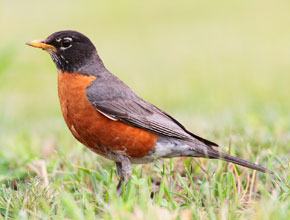What's in a Name?
What’s in a Name?
Long ago, the study of ancient Greek and Latin was a highly valued part of a formal education. Natural historians and other learned people commonly used Greek and Latin to communicate concepts and ideas, including the names of body parts, species, and groups of related species. Even though few people study Greek or Latin today, we are left with a legacy of scientific terminology based on Greek and Latin roots. Because these languages are dead (no longer used for everyday conversation) they remain useful for science because the meanings of Greek and Latin words are permanently fixed and universally understood. For this reason, most scientists continue the tradition of using Greek and Latin roots for naming species. A species name includes two words, the genus and species. These names are usually based on portions of Greek and Latin words, known as “stems,” often linked together into a single word, or Latinized versions of people or place names. Because millions of species have already been named and the number of words and word combinations that are available for new species are limited, it is often necessary to link many Latin and Greek stems together to make a very complex name.
Case Study – naming a new brontothere In 2004, four scientists (Matthew Mihlbachler, Spencer Lucas, Robert Emry, and Bolat Bayshashov) discovered, described, and named a large-bodied, short-footed Eocene brontothere from the Central Asian country of Kazakhstan. Its full scientific name is: “Aktautitan hippopotamopus Mihlbachler, Lucas, Emry, and Bayshashov.” The first two names are the genus and species, and the final four are the authors of the name. The paper describing the new species explains the etymology (“word history”) of the its name. The genus name is a combination of "Aktau" and "titan". "Aktau" is the name of the mountain in Kazakhstan where this species was discovered. "Titan" is the Greek word for giant . The species name, "hippopotamopus" combines "hippopotamus" and "opus". Hippopotamus in Greek literally means "river horse", which is an appropriate description for a living hippopotamus. "Opus" is Greek for "foot". The combination of these words refers to the very short feet of this new fossil animal, which resemble those of a living hippopotamus. So Aktautitan hippopotamopus could be translated as “Giant from Aktau with hippopotamus feet”
You can download a copy of the paper describing Aktautitan by following this link.
When a scientist describes a new species, they publish the name in a scientific paper, together with an explanation of the meaning of the name. You can see an example of how a species name is put together in the box on this page. Sir Richard Owen named the group of mammals including horses, rhinos, tapirs and extinct relatives Perissodactyla. Perissodactyl is derived from ancient Greek "perissos" meaning uneven, and "daktulos", a finger or toe. This name described the uneven numbers of fingers and toes that characterize most members of this group. Scientific names are important because they are universally understood, regardless of where you live or the language you speak. This is important in avoiding confusion over a species’ identity. For example in both North America and Europe there is a bird called a robin. But these are two very different and quite unrelated animals. Their species names make this quite clear: the American robin is Turdus migratorius, while the European robin is Erithacus rubecula. “Robin” has two different meanings, depending on whether you are European or American. But the species name is the same regardless of where you come from. For widely distributed species of plants and animals, which may have literally hundreds of different common names, this is extremely important. Throughout this website you will find many other genus names, family names, and genus species names. We’ve linked these to a glossary page where you can look up their meaning; you can decide for yourself whether or not the name is an adequate description.


European robin (Erithacus rubecula), American robin (Turdus migratorius)



